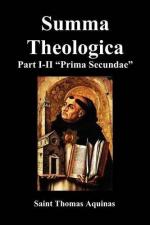But with regard to the figurative reason, the outward tabernacle, which was called the Holy Place, betokened the state of the Old Law, as the Apostle says (Heb. 9:6, seqq.): because into that tabernacle “the priests always entered accomplishing the offices of sacrifices.” But the inner tabernacle, which was called the Holy of Holies, signified either the glory of heaven or the spiritual state of the New Law to come. To the latter state Christ brought us; and this was signified by the high-priest entering alone, once a year, into the Holy of Holies. The veil betokened the concealing of the spiritual sacrifices under the sacrifices of old. This veil was adorned with four colors: viz. that of linen, to designate purity of the flesh; purple, to denote the sufferings which the saints underwent for God; scarlet twice dyed, signifying the twofold love of God and our neighbor; and violet, in token of heavenly contemplation. With regard to the state of the Old Law the people and the priests were situated differently from one another. For the people saw the mere corporeal sacrifices which were offered in the court: whereas the priests were intent on the inner meaning of the sacrifices, because their faith in the mysteries of Christ was more explicit. Hence they entered into the outer tabernacle. This outer tabernacle was divided from the court by a veil; because some matters relating to the mystery of Christ were hidden from the people, while they were known to the priests: though they were not fully revealed to them, as they were subsequently in the New Testament (cf. Eph. 3:5).
Reply Obj. 5: Worship towards the west was introduced in the Law to the exclusion of idolatry: because all the Gentiles, in reverence to the sun, worshipped towards the east; hence it is written (Ezech. 8:16) that certain men “had their backs towards the temple of the Lord, and their faces to the east, and they adored towards the rising of the sun.” Accordingly, in order to prevent this, the tabernacle had the Holy of Holies to westward, that they might adore toward the west. A figurative reason may also be found in the fact that the whole state of the first tabernacle was ordained to foreshadow the death of Christ, which is signified by the west, according to Ps. 67:5: “Who ascendeth unto the west; the Lord is His name.”
Reply Obj. 6: Both literal and figurative reasons may be assigned for the things contained in the tabernacle. The literal reason is in connection with the divine worship. And because, as already observed (ad 4), the inner tabernacle, called the Holy of Holies, signified the higher world of spiritual substances, hence that tabernacle contained three things, viz. “the ark of the testament in which was a golden pot that had manna, and the rod of Aaron that had blossomed, and the tables” (Heb. 9:4) on which were written the ten commandments of the Law. Now the ark stood between two “cherubim” that looked




